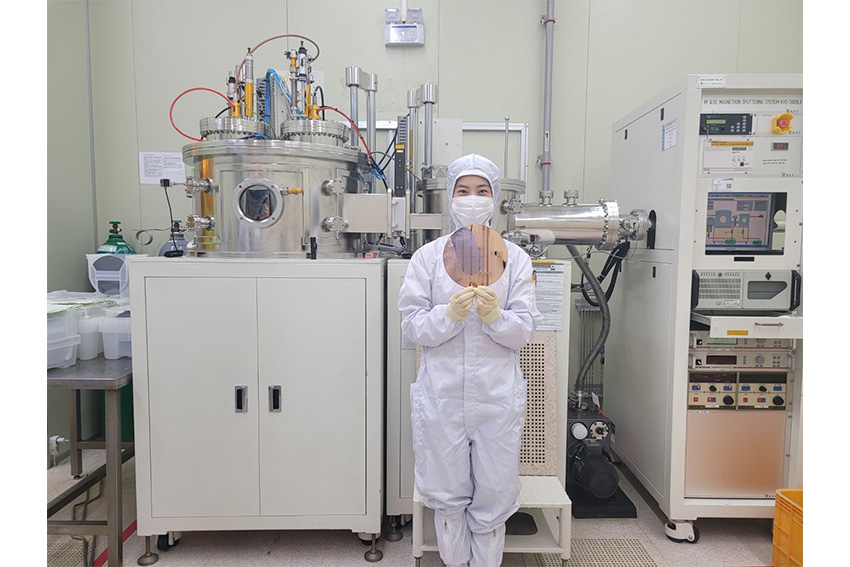Luken Technologies successfully mass-produces miniaturized POGO Pins through its MEMs factory, meeting the demand of the high-end semiconductor testing industry.

Over the past two years, there has been a persistent trend of the US endeavoring to relocate manufacturing domestically, while Europe has pursued similar strategies to bolster manufacturing within its borders. What is your perspective on the contribution of Korean SMEs to the global supply chain? How do you envisage Korean SMEs competing with China on one front and with Japan and Germany on the other?
Our competitiveness can be delineated by three key factors. Firstly, our agility in execution sets us apart. Secondly, our ability to reduce costs while ensuring efficient delivery is a significant advantage. Thirdly, our proficiency in automation and mass production enables us to rival contenders in Germany, Japan, and China.
Regarding the role of Korean SMEs in the global supply chain, we hold a prominent position, particularly in the OLED display sector, where display and semiconductor technologies constitute the backbone of the entire IT industry. In the realm of OLED, we proudly claim the top spot. Furthermore, in the realm of memory semiconductors, we maintain a competitive edge. Leveraging the expertise and experience gained from OLED displays, we have seamlessly integrated this technology into semiconductor development, further enhancing our competitive position. Additionally, we excel in niche markets, serving as a leading provider of semiconductor testing solutions for inspection materials and equipment, distinct from major players such as ASML or Intel.
Over the last decade, demand growth in the electronics and semiconductor industry was mainly driven by applications such as smartphones, consumer electronics and automotives. As new technologies, including AI, 5G and the Metaverse become mainstream, observers expect major changes in revenue streams. For example, NVIDIA Corporation, which has grown into a global leader in the production of AI microchips, saw revenue increase of 50% from the previous quarter. Looking at the next 3 to 5 years, what main technologies will be the new factors for growth? How will it affect the testing industry?
The trajectory ahead seems inevitable, focusing on enhancing human convenience and enjoyment. The thrust behind most automation or AI technologies is the aim to supplant human labor, whether it's in driving, factory work, or household chores. This eagerness to embrace AI automation and autonomous driving underscores the success enjoyed by companies like Nvidia. There's a burgeoning demand for AI systems capable of human-like thought and functionality, hence the growth witnessed in technologies like HBM. This trend isn't confined to the next three to five years; it's poised to shape the next century. Moreover, with the maturation of advanced AI, quantum computing is poised to experience significant growth.
Luken Technologies has proactively anticipated and prepared for this evolutionary trend. That's why we've developed our unparalleled M-POGO series. Much of the existing testing equipment struggles to keep pace with the speed of technological advancements. Probe cards and associated sockets often lag behind, even as the testing landscape grows increasingly complex. Ensuring sophistication in yield and failure analysis is paramount, and our M-POGO series excels in this regard. Meanwhile, SK Hynix's successful development of HBM3 and Samsung's pursuit of similar advancements underscore the unexpected nature of this evolution, even for industry giants.
Founded in 2007, Luken Technologies is a provider of post-process inspection equipment and components for the semiconductor and display industry. With a fully integrated R&D and manufacturing capability, Luken Technologies is capable of offering total testing solutions, integrating all the technologies such as M-POGO test sockets, M-POGO vertical probe card, as well as offering OLED specialized probe block unit and OLED inspection equipment, in order to compete against major probe cards makers. Could you elaborate on your technologies and how you managed to mass-produce it for larger companies?
At the outset of our journey, we didn't have the M-POGO series; instead, we employed a canti-type of pins. Unfortunately, we misread the exact needs of our clients at the time. The manual insertion of needles proved costly, while clients sought more budget-friendly options. This discrepancy led to financial setbacks. However, in 2014, after acquiring a probe card company, we faced further challenges, experiencing a deficit of 4 billion KRW over the subsequent two years. This prompted us to reevaluate our approach and identify key market demands: cost-effectiveness, high quality, and flexibility to meet client needs. In 2016, we embarked on developing the M-POGO series, concurrently divesting the acquired probe card company.
Since our acquisition of MEMS fab in 2011, we've allocated more than 1 billion KRW annually towards investment. Beginning in 2016, under the banner of the M-POGO series, we undertook material, design, and process development until the spring of 2022, when we launched the series in full force. Our commitment to this endeavor has been steadfast, with an annual investment of more than 1 billion KRW since 2011.
Connectors with a high number of pins often dictate pricing. You previously mentioned that initial investments in bent needles failed due to pricing and competitiveness issues. However, it seems that your M-POGO pins are more expensive than those of your competitors. How do you manage to maintain competitive pricing against other pogo pins?
The foundation of our price competitiveness lies in the MEMS process. When you consider an eight-inch wafer, attaching approximately 50,000 to 100,000 pins to it incurs minimal costs thanks to the MEMS process.
We are able to provide high-quality, cost-effective products to our clients because we've implemented the MEMS process in developing our M-POGO pins. This process offers higher frequency and density compared to traditional machinery processes for pogo pins. Additionally, as our clients increasingly demand higher speed and low-power memory solutions, our pins typically range from $1 to $10 each, depending on factors such as the number of grounds and channels, as well as the size of the pins. While conventional pins may cost mere cents, our pins, with their advanced features and capabilities, command a higher price point, typically exceeding $1.
The M-POGO series offers a range of products with varying thicknesses. How do you tailor your solutions to meet the diverse needs of your clients?
We entered the scene relatively recently with the M-POGO series, which was launched just two years ago. Conglomerates often approach us either due to our competitive pricing or because we offer solutions to challenges they cannot address internally. We've ventured into uncharted territory where these giants have previously tread. Our success in this arena has been notable, and semiconductor division is set to be fully operational starting next year. As we move forward, our focus will be on refining our marketing and sales strategies, beginning this year.
Leveraging your M-POGO pin technology, you're able to design and customize various testing solutions. What does it entail in terms of R&D and customization to achieve this level of design, and what advantages do you have over competitors?
Our capabilities set us apart significantly from competitors. While some competitors are specialized in probe cards, they rely on purchasing multi-layer ceramic boards from external sources. In contrast, our in-house production process marks a substantial advantage over them. Furthermore, our M-POGO pin insertion process is automated, further streamlining efficiency. This combination of in-house production, simplified processes, and automated procedures positions us uniquely against competitors.

MEMS Fab
In 2022, Luken acquired an AI algorithm company with the aim of enhancing the competitiveness of your equipment through unmanned automatic inspection. Could you elaborate on how you envision the evolution of your product offering, and how does AI align with your corporate strategy?
We believe that automation is the future for both the OLED display and semiconductor industries. AI integration is essential to reducing costs and implementing unmanned inspection processes. Previously, tasks such as inspecting the resolution of OLED displays in devices like Apple's tablets or smartphones were carried out manually. However, our automated camera vision system now handles this inspection, significantly improving yield and failure rate analysis. This groundbreaking shift in processing represents a pivotal moment for the industry. Looking ahead, our focus is on two key solutions. Firstly, we aim to apply the AI algorithms we've developed to semiconductor inspection processes. Secondly, we're exploring how to integrate these algorithms into PCB and wafer-level packaging inspections. We're currently in discussions with industry leaders regarding these initiatives.
It's indeed an exciting time for your company as you've fully launched your testing solutions for the semiconductor industry. This year, you're collaborating with major semiconductor companies and distributors in China for your M-POGO series. Looking ahead over the next three to five years, what objectives and benchmarks have you set for yourself and your company, particularly in terms of internationalization?
On a personal level, my aim is to establish a comprehensive lineup of inspection, testing, and contacting equipment. For our corporate aspirations, I envision positioning our company as the leading vertical probe card specialist globally. In the HBM market, our goal is to become the foremost provider of test sockets and probe cards worldwide.
We anticipate a significant market paradigm shift in the coming years. My corporate ambition is for us to emerge as the premier wafer-level packaging solution provider, leveraging our unparalleled expertise within the next five years. As we embark on this developmental journey, the M-POGO series will undoubtedly play a pivotal role in our initial stages of advancement.
0 COMMENTS